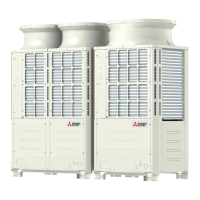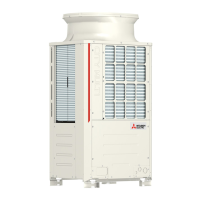What does Error Code 1500 mean on a Mitsubishi Electric PUHY-P144 Air Conditioner?
- VvanessawatsonSep 10, 2025
If your Mitsubishi Electric Air Conditioner is showing Error Code 1500, it indicates a refrigerant overcharge.

What does Error Code 1500 mean on a Mitsubishi Electric PUHY-P144 Air Conditioner?
If your Mitsubishi Electric Air Conditioner is showing Error Code 1500, it indicates a refrigerant overcharge.
What does Error Code 4220 or 4225 mean on my Mitsubishi Electric PUHY-P144 Air Conditioner?
Error Codes 4220 and 4225 on your Mitsubishi Electric Air Conditioner can indicate abnormal bus voltage drop or rise, a logic error, or low bus voltage at startup.
What does Error Code 7100 mean on Mitsubishi Electric Air Conditioner?
If your Mitsubishi Electric Air Conditioner is showing Error Code 7100, this indicates a total capacity error.
What does Error Code 7105 mean on a Mitsubishi Electric PUHY-P144 Air Conditioner?
If your Mitsubishi Electric Air Conditioner displays Error Code 7105, it means there is an address setting error.
What does Error Code 5301 mean on a Mitsubishi Electric PUHY-P144 Air Conditioner?
If your Mitsubishi Electric Air Conditioner is showing Error Code 5301, it indicates an ACCT sensor fault.
What does Error Code 2600 mean on a Mitsubishi Electric PUHY-P144?
If your Mitsubishi Electric Air Conditioner is showing Error Code 2600, it indicates water leakage.
What does Error Code 6606 mean on a Mitsubishi Electric PUHY-P144 Air Conditioner?
If your Mitsubishi Electric Air Conditioner displays Error Code 6606, it indicates a communication error between the device and transmission processors.
What does Error Code 7117 mean on a Mitsubishi Electric Air Conditioner?
If your Mitsubishi Electric Air Conditioner displays Error Code 7117, it indicates a model setting error.
What does Error Code 7113 mean on a Mitsubishi Electric PUHY-P144 Air Conditioner?
If your Mitsubishi Electric Air Conditioner displays Error Code 7113, it indicates a function setting error.
What does Error Code 6600 mean on a Mitsubishi Electric PUHY-P144 Air Conditioner?
If your Mitsubishi Electric Air Conditioner displays Error Code 6600, it indicates an address overlap.
| Model | PUHY-P144 |
|---|---|
| Cooling Capacity | 144, 000 BTU/h |
| Refrigerant | R410A |
| Power Supply | 3-phase |
| Type | Air Conditioner |
| Operating Temperature (Cooling) | -5°C to 46°C |
| Operating Temperature (Heating) | -4°F to 60°F (-20°C to 16°C) |
| Voltage (V) | 208/230 V |
Essential guidelines for safe unit operation and maintenance.
Procedures and precautions for safely moving and installing the unit.
Guidelines for proper installation to ensure safety and prevent damage.
Precautions and procedures for connecting refrigerant pipes.
Safety precautions and procedures for electrical wiring connections.
Guidelines for safely moving and repairing the unit.
Further safety and operational advice for unit installation and maintenance.
Steps for preparing piping before servicing the unit.
Information on materials, refrigerant, and oil for proper handling.
Procedures for safely working with refrigerant piping.
Safety measures and guidelines for wiring work.
Overview of compatible indoor units for different outdoor unit types.
Specifications for transmission and remote controller cable types and lengths.
Necessary switch settings based on system configuration.
Procedures for setting M-NET addresses for system components.
Explanation of demand control functionality and its settings.
Illustrative examples of typical system connections.
Wiring and settings for systems using an MA remote controller.
Wiring and settings for systems using an ME remote controller.
Wiring and settings for systems using both MA and ME remote controllers.
Guidelines on refrigerant pipe length and size restrictions.
Visual identification of outdoor unit components and refrigerant circuits.
Diagrams illustrating the refrigerant flow within the outdoor unit.
Detailed explanation of the functions of key outdoor unit components.
Detailed explanation of the functions of key indoor unit components.
Layout and identification of components within the outdoor unit circuit box.
Detailed list and functions of components on the outdoor unit circuit boards.
Electrical diagrams showing the wiring of the outdoor unit.
Electrical diagrams for the transmission booster.
Explanation of dipswitch functions and default settings for various units.
Details on the control mechanisms and operations of the outdoor unit.
Visual flowcharts illustrating unit operation sequences.
Important precautions and checks before performing a test run.
Comparison of functions and specifications for MA and ME remote controllers.
Procedures for setting up groups and interlocks using an ME remote controller.
How to select and configure functions using an ME remote controller.
Steps for configuring interlock settings with an MA remote controller.
Adjusting the location for room temperature sensing.
Step-by-step instructions for conducting a test run.
Understanding operational characteristics and refrigerant charge.
Methods for assessing and adjusting refrigerant levels.
Identifying normal operational symptoms that may appear unusual.
Reference data for standard unit operation parameters.
Lists of preliminary and main error codes for quick reference.
Detailed definitions and solutions for error codes 0-999.
Detailed definitions and solutions for error codes 1000-1999.
Detailed definitions and solutions for error codes 2000-2999.
Detailed definitions and solutions for error codes 4000-4999.
Detailed definitions and solutions for error codes 5000-5999.
Detailed definitions and solutions for error codes 6000-6999.
Detailed definitions and solutions for error codes 7000-7999.
Troubleshooting common issues with MA remote controllers.
Troubleshooting common issues with ME remote controllers.
Diagnosing and resolving issues related to refrigerant control.
Procedures for checking transmission signals and electrical noise.
Diagnosing issues with pressure sensors and their circuits.
Identifying and resolving problems with solenoid valves.
Diagnosing and fixing issues with outdoor unit fans.
Identifying and resolving problems related to LEV (Linear Expansion Valve) operation.
Troubleshooting common issues related to the inverter system.
Troubleshooting common issues related to the inverter system.
Understanding and troubleshooting the control circuit for TLMU models.
Understanding and troubleshooting the control circuit for YLMU models.
Procedures for identifying and addressing refrigerant leaks.
Step-by-step guide for replacing the compressor.
Instructions for replacing the heat exchanger.
Using LED indicators to diagnose outdoor unit problems.
General information on LED status indicators for troubleshooting.
Guide on interpreting LED displays for status information.
Information displayed on LEDs during initial unit startup.
Explanation of the unit's clock memory function for time tracking.
Comprehensive table detailing LED status codes and their meanings.











